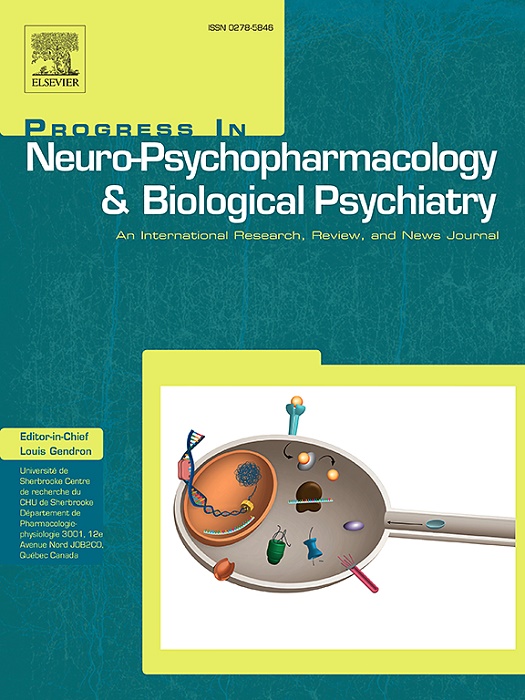A plasma protein profile of antidepressant response to omega-3 fatty acids
IF 3.9
2区 医学
Q1 CLINICAL NEUROLOGY
Progress in Neuro-Psychopharmacology & Biological Psychiatry
Pub Date : 2025-08-30
DOI:10.1016/j.pnpbp.2025.111481
引用次数: 0
Abstract
Background
Previous studies suggest an antidepressant effect of omega-3 fatty acids (n-3 PUFAs). This effect may be larger in patients with low-grade inflammation, defined as mild elevations of high sensitivity C-reactive protein or other commonly used inflammatory markers. The antidepressant mechanisms of n-3 PUFAs are not fully understood but may involve modulation of immunometabolic processes and neurotrophic effects. Here we investigated inflammatory and cardiometabolic biomarkers in patients with major depressive disorder (MDD) and controls, how these biomarkers change with n-3 PUFA treatment, and their association with antidepressant response.
Methods
Ninety-four MDD patients were treated with 2.2 g eicosapentaenoic acid, 400 mg docosahexaenoic acid, and 800 mg other omega-3 fatty acids per day, added to stable antidepressant treatment for 8 weeks. Inflammatory and cardiometabolic plasma markers were assayed in MDD patients, before and after n-3 PUFA treatment, and in healthy controls (n = 76) using proximity extension assay technology. Treatment response was defined as ≥50 % reduction on the 17-item Hamilton Depression Rating Scale. Partial least squares discriminant analysis identified plasma proteins with differential levels between patients, controls, responders, and non-responders.
Results
After adjusting for relevant covariates and multiple comparisons, baseline levels of several biomarkers associated with immunometabolic functions and neurotrophic processes differed significantly between MDD patients and controls and between n-3 PUFA responders and non-responders. Some of these biomarkers, related to cell-cell communication and neurotrophy, increased significantly with treatment.
Conclusion
These findings provide new insights into the antidepressant mechanisms of n-3 PUFAs. Consistent with previous reports, we found evidence of pre-treatment immune activation in responders compared to non-responders, which could be used to personalize antidepressant n-3 PUFA treatment.
抗抑郁药对-3脂肪酸反应的血浆蛋白谱
之前的研究表明omega-3脂肪酸(n-3 PUFAs)具有抗抑郁作用。这种影响在低度炎症患者中可能更大,低度炎症定义为高敏c反应蛋白或其他常用炎症标志物的轻度升高。n-3 PUFAs的抗抑郁机制尚不完全清楚,但可能涉及调节免疫代谢过程和神经营养作用。在这里,我们研究了重度抑郁症(MDD)患者和对照组的炎症和心脏代谢生物标志物,这些生物标志物如何随着n-3 PUFA治疗而变化,以及它们与抗抑郁反应的关系。方法94例重度抑郁症患者每日服用2.2 g二十碳五烯酸、400 mg二十二碳六烯酸和800 mg其他omega-3脂肪酸,并在稳定抗抑郁治疗的基础上治疗8周。采用接近延伸检测技术检测MDD患者、n-3 PUFA治疗前后以及健康对照(n = 76)的炎症和心脏代谢血浆标志物。治疗反应定义为17项汉密尔顿抑郁评定量表减少≥50%。偏最小二乘判别分析确定了患者、对照组、应答者和无应答者之间血浆蛋白水平的差异。在调整相关变量和多次比较后,与免疫代谢功能和神经营养过程相关的几种生物标志物的基线水平在MDD患者和对照组之间以及n-3 PUFA应答者和无应答者之间存在显著差异。其中一些与细胞间通讯和神经萎缩相关的生物标志物在治疗过程中显著增加。结论本研究为研究n-3 PUFAs的抗抑郁作用机制提供了新的思路。与之前的报道一致,我们发现了治疗前免疫激活的证据,反应者与无反应者相比,这可以用于个性化抗抑郁药n-3 PUFA治疗。
本文章由计算机程序翻译,如有差异,请以英文原文为准。
求助全文
约1分钟内获得全文
求助全文
来源期刊
CiteScore
12.00
自引率
1.80%
发文量
153
审稿时长
56 days
期刊介绍:
Progress in Neuro-Psychopharmacology & Biological Psychiatry is an international and multidisciplinary journal which aims to ensure the rapid publication of authoritative reviews and research papers dealing with experimental and clinical aspects of neuro-psychopharmacology and biological psychiatry. Issues of the journal are regularly devoted wholly in or in part to a topical subject.
Progress in Neuro-Psychopharmacology & Biological Psychiatry does not publish work on the actions of biological extracts unless the pharmacological active molecular substrate and/or specific receptor binding properties of the extract compounds are elucidated.

 求助内容:
求助内容: 应助结果提醒方式:
应助结果提醒方式:


